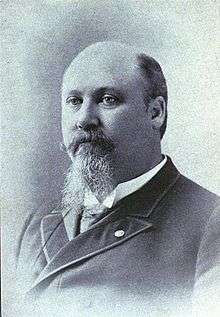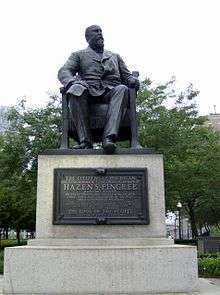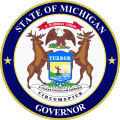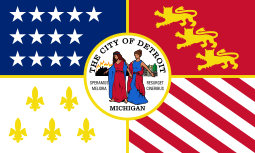Hazen S. Pingree
| Hazen S. Pingree | |
|---|---|
 | |
| 24th Governor of Michigan | |
|
In office January 1, 1897 – January 1, 1901 | |
| Lieutenant |
Thomas B. Dunstan Orrin Williams Robinson |
| Preceded by | John Tyler Rich |
| Succeeded by | Aaron Thomas Bliss |
| Mayor of Detroit, Michigan | |
|
In office 1889–1897 | |
| Preceded by | John Pridgeon, Jr. |
| Succeeded by | William Richert |
| Personal details | |
| Born |
August 30, 1840 Denmark, Maine |
| Died |
June 18, 1901 (aged 60) London, England |
| Political party | Republican |
| Spouse(s) | Frances Gilbert |
| Religion | Baptist |
Hazen Stuart Pingree (August 30, 1840 – June 18, 1901) was a four-term Republican mayor of Detroit (1889–1897) and the 24th Governor of the U.S. State of Michigan (1897–1901). A Yankee who migrated from New England, he was a Georgist social reformer who battled corporations and was an early leader of the Progressive Movement.
A businessman with no political experience, Pingree was elected mayor in 1889 after a colorful campaign in which Pingree revealed his tolerance by making a circuit of saloons. Pingree added to the old stock Yankee Republican base by making large inroads into the German and Canadian elements. He was reelected in 1891, 1893 and 1895. Warning repeatedly against the dangers of government by corporations, he launched nationally visible crusades against Detroit's streetcar, gas, electric, and telephone companies. He successfully forced rate reductions that won him widespread popularity. He won public approval for a citizen-owned electric light plant, and became a national spokesman for municipal ownership and close regulation of utilities and street railways. When the nationwide Panic of 1893 caused a severe depression, Pingree gained support by opening empty lots to garden farming – people called him "Potato Patch Pingree." Pingree was a Republican, and had nothing to do with the Populist Party that had considerable support among labor union members. He supported the gold standard in 1896, and worked to carry Michigan for William McKinley over silverite William Jennings Bryan in the intensely competitive 1896 U.S. presidential election. Pingree was on the ballot, too, and was elected governor of Michigan. As governor, he fought a strong conservative opposition, but did succeed in forcing passage of the nation's first major statewide reappraisal of railroad and corporate property, with an eye to raising their taxes. This led to a rational basis for railroad regulation and taxation, emulated by Progressive reformers in other states and nationwide.[1] A survey of scholars in 1999 ranked Pingree as the fourth best mayor in all of American history.[2]
Early life in Maine and Massachusetts
Pingree was born in Denmark, Maine, to Jasper Pingree and Adeline (Bryant) Pingree and attended the common schools in Maine.[3] At the age of fourteen, he moved to Saco, Maine, where he worked at a cotton factory. Two years later, he moved to Hopkinton, Massachusetts, and worked several years as a cutter in a shoe factory.[3]
Civil War
In 1862, Pingree enlisted in the Union Army to serve in the Civil War with the 1st Massachusetts Heavy Artillery Regiment (Company F). He fought on the front line during General Pope’s Northern Virginia Campaign and the Second Battle of Bull Run. The regiment he fought with was then ordered to defend Washington, D.C. until May 15, 1864, and then was sent to the front again. He fought with the Second Brigade of Tyler’s Division, Second Corps, which participated in battles at Fredericksburg Road (May 18), Harris Farm (May 19), and Spotsylvania Court House (May 19–21).[3]
His regiment was then assigned to the Second Corps, Third Division, in the Army of the Potomac and fought at North Anna (May 24–25) where he and some other men were captured by a detachment of John S. Mosby’s command. Pingree was confined in Confederate prisons at Gordonsville and Lynchburg, Virginia, and at Salisbury, North Carolina. He was then taken to Andersonville prison and, while General Sherman was on his march to the sea, he was taken to Millen, Georgia, where he later escaped by pretending to be someone else during a roll call for a prisoner exchange in November 1864. Pingree rejoined his regiment, fought in many more battles, and was present at Appomattox Court House when Robert E. Lee surrendered on April 9, 1865. A few months later, on August 15, his regiment was mustered out.[3]
Business in Michigan
Pingree was a cobbler by trade and, following the war, moved to Detroit and briefly worked for H. P. Baldwin's shoe company.[3] In 1866, Pingree and his accountant, Charles H. Smith, purchased Baldwin's shoe-making machinery and formed the Pingree and Smith company. In 1883, Smith retired from the firm and J. B. Howarth and Pingree's son Joe joined the partnership.[3] By 1886, it was 1 million dollar company with 700 employees turning out a half-million shoes and boots a year. It was the second biggest shoe manufacturer in the U.S. In March 1887, a fire destroyed the entire plant, yet they were able to recover. [4][5]
In 1872, Pingree married Frances A. Gilbert of Mount Clemens, Michigan. They had three children – Joe, Hazel, and Gertrude, who died in 1894 of tuberculosis at age 19.[6]
Mayor of Detroit
Pingree had never been active in politics. As a citizen reformer he was elected mayor of Detroit in 1889 on a platform of exposing and ending corruption in city paving contracts, sewer contracts, and the school board. He soon turned to fighting privately owned utility monopolies. He challenged the electric and gas monopolies through municipally owned competitors.[5] His largest struggle, however, was with Tom L. Johnson, president of the Detroit City Railways, over lowering streetcar fares to three-cents. Pingree again attempted to create a competing municipally owned company, but was barred from creating a railway by the Michigan Constitution.[7]
During the severe nationwide depression of 1893, Pingree expanded the public welfare programs, initiated public works for the unemployed, built new schools, parks, and public baths. He gained national recognition through his "potato patch plan," which allowed poor people to use vacant city land for growing food. He was also an advocate of economist Henry George's single tax.[7]
Governor of Michigan
In 1896 Pingree was nominated as the GOP candidate for Governor of Michigan. He campaigned on a platform of pluralism, inviting the Germans and other ethnics to join a grand coalition that would bring prosperity to everyone, unlike the false prosperity promised by the silverites. He carried the state both for himself and Republican presidential candidate William McKinley.[8]
After taking office on January 1, 1897, he intended to also fill the last year of his term as mayor of Detroit, which would have lasted until elections in November 1897. However, his right to hold the two offices simultaneously was contested, and after the Michigan Supreme Court ruled against him, Pingree resigned as mayor.[5]
During his four years in office, Pingree promoted the regulation of railroad rates, equal taxation, and municipal ownership of public utilities. He also supported the direct election of U.S. senators; an eight-hour workday; an income tax; primary elections; the power of "referendum," the abolition of child labor, and compulsory arbitration of labor disputes. Opposition from Democrats and business-oriented Republicans blocked most of his proposals. Pingree expressed the Progressive fear of corporate power, saying, "I do not condemn corporations and rich men," he said, "but I would keep them within their proper spheres. It is not safe to entrust the government of the country to the influence of Wall Street."[9]
Death
Pingree did not run for reelection in 1900. In 1901, Pingree arrived in London, England, while returning from an African safari with his son. He was stricken with peritonitis and was unable to return to the U.S. King Edward VII, Pingree’s famous look alike, even sent his own physicians to London's Grand Hotel to assist in Pingree's recovery.[6]
Pingree was interred at the Elmwood Cemetery, Detroit, Michigan, and later reinterred at the Woodlawn Cemetery in Detroit.[10] There is a statue of Pingree standing in the Grand Circus Park in Detroit, commemorating him as "The Idol of the People."[11] The sculpture was made by Austrian sculptor Rudolph Schwarz.
See also
References
- ↑ Melvin G. Holli, Reform in Detroit: Hazen S. Pingree and Urban Politics (1969)
- ↑ Melvin G. Holli (1999). The American Mayor: The Best & the Worst Big-City Leaders. Penn State University Press. p. 35.
- 1 2 3 4 5 6 = Western Publishing and Engraving Co. (1900), CYCLOPEDIA OF MICHIGAN: HISTORICAL AND BIOGRAPHICAL, COMPRISING A SYNOPSIS OF GENERAL HISTORY OF THE STATE, ABD BIOGRAPHICAL SKETCHES OF MEN, Western Publishing and Engraving Co., pp. 144–146
- ↑ Bill Loomis, "Hazen Pingree: Quite possibly Detroit's finest mayor" (2013)
- 1 2 3 Catlin, George B. (2005) [1900]. "Chapters CI through CVII". The story of Detroit. pp. 585–630.
- 1 2 Don Lochbiler (June 11, 1998). "The Shoemaker Who Looked Like a King". The Detroit News.
- 1 2 Holli, 1970
- ↑ Richard J. Jensen (1971). The Winning of the Midwest: Social and Political Conflict, 1888-1896. U of Chicago Press. pp. 292, 295.
- ↑ Russel B. Nye, Midwestern Progressive Politics: A Historical Study of Its Origins and Development, 1870-1950 (1951) p 205
- ↑ "Index to Politicians: Pincus to Pingry". Political Graveyard. Retrieved October 30, 2010.
- ↑ Pat Zacharias (September 5, 1999). "The monuments of Detroit". The Detroit News.

Further reading
- Holli, Melvin G. The American Mayor: The Best & the Worst Big-City Leaders (1999) pp 35–75
- Holli, Melvin G. "Mayor Pingree Campaigns for the Governorship," Michigan History (1973) 57#2 pp 151–173.
- Holli, Melvin G. Holli (1969), Reform in Detroit: Hazen S. Pingree and Urban Politics, Oxford University Press
- Holli, Melvin G. (1966), Hazen S. Pingree: urban and pre-progressive reformer, U. of Michigan PhD dissertation
- Loomis, Bill. "Hazen Pingree: Quite possibly Detroit's finest mayor," The Detroit News Jan 6, 2013'
- Marden, Orison Swett, Hazen S. Pingree: A Good Shoemaker Becomes Detroit's Best Mayor and Michigan's Greatest Governor, Kessinger Publishing
- Sych, Lawrence. "Political Clubs In Michigan Election Campaigns: A Comparison of the Pingree and Griffin Campaigns," Michigan Academician (2002) 34#2 pp 143–162. compares 1896 and 1978
Primary sources
- George Fuler (ed.), Messages of the Governors of Michigan, Volume 4, Michigan State University Press, ISBN 978-0-87013-723-5
- Hazen S. Pingree (1895), Facts and opinions: or, Dangers that beset us, F. B. Dickerson Co.
- Hazen S. Pingree (1897), Message of Governor Hazen S. Pingree to the thirty-ninth legislature of Michigan: Delivered Jan. 6, 1897; Volume 8 of Pamphlets on U.S. history and politics, R. Smith Printing Co.
- Hazen S. Pingree (1900), Message of Governor Hazen S. Pingree to the fortieth legislature convened in extra session: Upon the subjects of equal taxation, constitutional amendment, and repeal of special charters of railroads. October 10, 1900, Wynkoop Hallenbeck Crawford co., state printers
| Political offices | ||
|---|---|---|
| Preceded by John Pridgeon, Jr. |
Mayor of Detroit 1889–1897 |
Succeeded by William Richert |
| Preceded by John T. Rich |
Governor of Michigan 1897–1901 |
Succeeded by Aaron T. Bliss |

